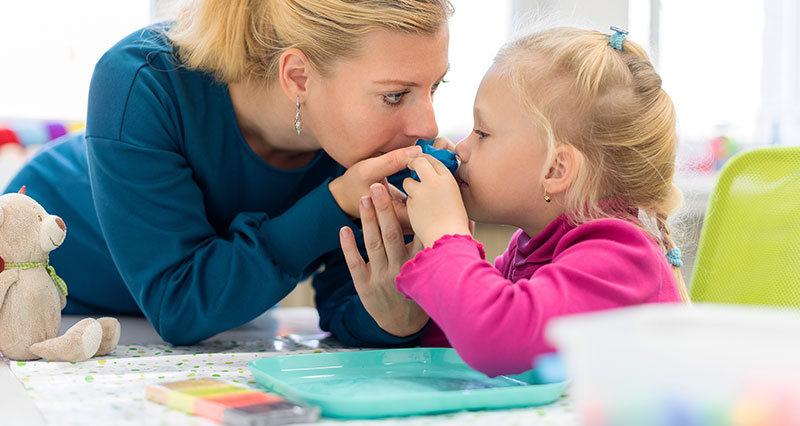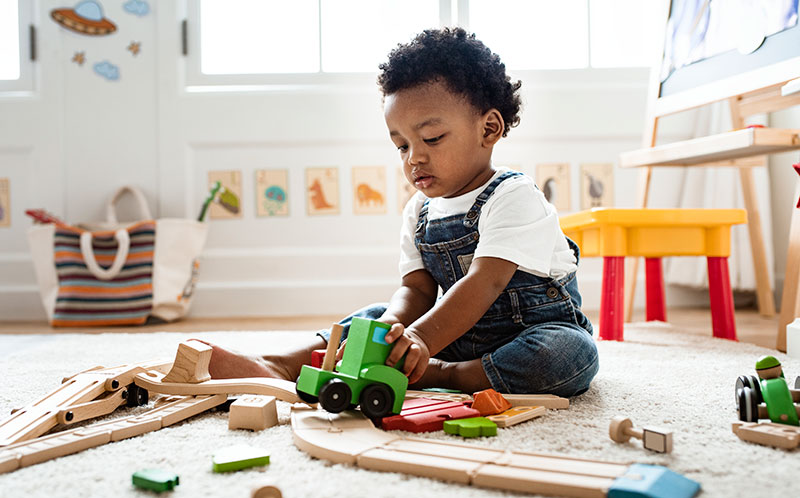[vc_row][vc_column][vc_column_text]Whether alone, with parents, with a friend, or in a group, play is an essential part of childhood that’s crucial for the optimal growth of humans at all ages.
Play: A Human Right
Play is such an important part of child development that the United Nations High Commission for Human Rights recognizes it as a fundamental right every child has. Unfortunately, studies increasingly show many children encounter significant obstacles to ample, age-appropriate playtime. From the exploitative practices of child labor to the traumas of war and domestic violence, our world often fails to make the right to play accessible to children across the globe.
Even in areas enjoying relative peace, parents constrained by the global crisis of poverty find their families limited by insufficient resources. Children in the world’s wealthiest nations may be fortunate enough to live among abundance, but many are also raised in a hurried, pressured manner which precludes the opportunity to engage in child-directed play. In a report published in the journal Pediatrics, the Committee on Psychosocial Aspects of Child and Family Health warned that could have major repercussions for the bonds between parents and their kids — as well as society more broadly.
Child advocates acknowledge no single set of guidelines could address all the multifaceted issues that impact children’s play. Nevertheless, the committee stressed that the various forces preventing children with disabilities, families in poverty, and those affected by global crises from accessing the full benefits of free play deserve urgent attention and action. In conjunction, the committee urges families, caregivers, school systems, and communities to get the ball rolling locally by prioritizing and protecting play as a necessary component of ideal human development.
Why Is Play So Essential?
Scientists in the field of child development and psychology unanimously agree that play is imperative for a child’s learning and development, as well as for building their sense of confidence and well-being. When children play, they can experience and express feelings of love, happiness, and safety — but the rewards of play go far beyond the emotional perks of recreation. The benefits of play are as limitless as the forms it can take, but here are a few of the significant things play can do:
- Build self-awareness
- Develop communication
- Increase social connection
- Teach language and numeracy
- Foster bonds with the environment
- Enhance physical dexterity and strength
- Encourage compassion and cooperation
Play is not only central to healthy emotional, physical, and social growth of children. It’s also the primary way a child will cope with and process stress. This is another great reason to require a recess: Kids need time to unwind and express themselves while they learn to identify and interact with their emotions. In the interim, playtime can be very educational for adults in a child’s care community. There are many ways play can act as a portal of insight into a child’s individual personality — giving a glimpse of their interests, talents, and challenges.
What Counts As Play?
So, what qualifies as play? Any safe activity that excites and engages a child in a healthy, supportive way can fit the description, but one thing is sure: that answer will adapt over time and vary from child to child. As children grow more comfortable in their bodies and understand more complex concepts, playtime will morph through a plethora of formats at different stages of life. Older children are sure to leave behind toys and activities that once captured their attention, seek out or create new toys, and grow more physically active and agile.
With new capacities and experiences accruing with age, kids are likely to ask for more complicated toys, games, and puzzles. Thankfully, adults can help — and even get in on the fun — by being aware of a variety of activities that help children explore and expand their understanding of themselves and the world they live in. Playful interactions are beneficial to both children and adults in myriad ways, and dismissing play as a mere dalliance can seriously impair a young person’s ability to mature.
Unstructured Play Is Second to None
With the amazing diversity of personalities and preferences that kids can have, it may seem odd that there’s one integral play format that fits all — but researchers and pediatricians agree: Unstructured, free play is a required part of any romp routine. What does that mean? Specifically, it refers to play that is directed by the child’s interests in the moment and which is flexible to their desires.
Of course, newborns won’t know what their desires and interests are — outside of being interested in food or desiring a nap, of course. The littlest babes also don’t understand what’s safe and what’s not yet, so the first few years of play will require a lot of input and observation from parents and caregivers. Even so, babies will give honest feedback about what they enjoy and what they don’t. Adults can use that information to design playtime around baby’s preferences until they grow big enough to build upon that foundation of fun on their own.
At any age, children may enjoy company at playtime or prefer to play solo, and either is fine. When kids ask adults for feedback, participation, suggestions, or instructions on how to play, it never hurts to check in and ask whether they want direction or are inviting you to join in on a jolly time. Whether playing a game with rules, bursting into a spontaneous sing-a-long with new dance moves, or building with toys, children may want to get creative or change course at a moment’s notice — and that’s okay! Parents and caregivers can facilitate this by intentionally creating safe spaces and making time for self-directed play. As kids get older, it’s also a good idea to set kids-only play dates where no grown-ups get to decide what to do and how to do it.[/vc_column_text][/vc_column][/vc_row][vc_row][vc_column][vc_column_text]
Age-Appropriate Activities
With so many options to choose from and a wide spectrum of interests and abilities, it’s not unusual to feel awash in a sea of playful possibilities. Certainly, there are some play activities that aren’t safe or accessible for the youngest among us, and older kids probably won’t be entertained by hide-and-seek for long. Fortunately, child researchers researchers put a lot of attention toward understanding why kids enjoy the sorts of play they do, what benefits come from different types of play, and age estimates that can predict when children may start to outgrow certain activities or toys. Using that data, child advocacy and parenting groups have compiled lists of the biggest playtime hits to create a sort of recipe for rollicking where the main ingredients are age and developmental stages.[/vc_column_text][/vc_column][/vc_row][vc_row bg_type=”bg_color” bg_color_value=”#f7f7f7″][vc_column width=”1/6″][/vc_column][vc_column width=”2/3″ css=”.vc_custom_1603826956476{margin-top: 20px !important;margin-bottom: 20px !important;background-color: #ffffff !important;}”][vc_custom_heading text=”Play for Newborns: 0-3 Months” font_container=”tag:h2|text_align:center|color:%23ffffff” use_theme_fonts=”yes” css=”.vc_custom_1603826241232{padding-top: 20px !important;padding-right: 5px !important;padding-bottom: 20px !important;padding-left: 5px !important;background-color: #4e7f7b !important;}”][vc_column_text]In the earliest stages of life, parents and caregivers are the best playthings a kid could ask for. Simple things like making funny faces, gentle tickles, and lullabies really are sweet at this stage — which is all about interaction. Playing together helps your baby get to know and trust the people around them, and it also helps with brain development and speech skills. Parents can also glean insights into their infant’s personality through play, like whether they enjoy silly and physical play or prefer calm, quiet activities. Following your baby’s cues is important, too. Even newborns with a lot of energy may not always appreciate tickles or could startle and become overwhelmed, and that can compromise their sense of safety and security.[/vc_column_text][vc_toggle title=”Face Play”]Making funny facial expressions and simple gestures is sure to fascinate newborn babies. At this stage of development, babies love watching faces, and they can learn a lot about expressions and body language by doing so. Face-to-face play is also an easy, toy-free distraction during diaper changes.[/vc_toggle][vc_toggle title=”Object Play”]Soft toys, rattles, and textured books offer a chance to play with sensations and learn about the world. Object play can also be helpful in establishing stable, consistent routines with your newborn. Better yet, it also can provide comfort, especially when a child develops an affinity for a particular toy or item.[/vc_toggle][vc_toggle title=”Physical Play”]Count fingers and toes, blow raspberries, and tickle tummies — but consent is critical for this kind of play to be a success. If your newborn recoils from touch or fusses, it’s a good idea to stop immediately and try something else, like gently swaying with your swaddled babe or letting them play around in a bassinet.[/vc_toggle][vc_toggle title=”Story Time”]Your newborn won’t know many words, but it’s never too soon to start reading and sharing stories. Hearing the voices of parents and caregivers is very comforting to infants, and it’s one of the first ways they learn to recognize family members. It also helps them learn speech patterns and vowel sounds to practice.[/vc_toggle][vc_toggle title=”Tummy Time”]To encourage your baby to lift their head and look around, it’s a important to give your newborn some time on their tummy in a clear area every day for at least a few minutes. This helps them strengthen and grow their muscles, and gives them a safe space to practice rolling, crawling, and other movement. This can also prevent flat spots on your babies soft head.[/vc_toggle][vc_toggle title=”Verbal Play”]Singing, chatting, and nursery rhymes are all activities that are beloved by babies. It’s also a great opportunity to introduce your child to language and other elements of their culture. When your baby burbles or starts making sound, mimicking what you hear in response helps infants build and enjoy social connection.[/vc_toggle][vc_toggle title=”Visual Play”]Mobiles, photographs of faces, art cards, and window watching are all excellent examples of visual play. Remember that newborns can only see about 20-30 centimeters in front of their faces, and giving them a range of things to look at and focus on helps their eyesight grow stronger. It also helps them gain environmental familiarity.[/vc_toggle][/vc_column][vc_column width=”1/6″][/vc_column][/vc_row][vc_row][vc_column][vc_column_text]
Our Favorite Toys for Newborns
[/vc_column_text]
[/vc_column][/vc_row][vc_row bg_type=”bg_color” bg_color_value=”#f7f7f7″][vc_column width=”1/6″][/vc_column][vc_column width=”2/3″ css=”.vc_custom_1603826956476{margin-top: 20px !important;margin-bottom: 20px !important;background-color: #ffffff !important;}”][vc_custom_heading text=”Play for Babies: 3-12 Months” font_container=”tag:h2|text_align:center|color:%23ffffff” use_theme_fonts=”yes” css=”.vc_custom_1603827017145{padding-top: 20px !important;padding-right: 5px !important;padding-bottom: 20px !important;padding-left: 5px !important;background-color: #4e7f7b !important;}”][vc_column_text]After just 3 months, babies will be more physically active and attentive than newborns — especially when it comes to moving arms and legs. Since they’ll also be spending less time sleeping as they get older, babies may be eager to explore when they feel energetic because that’s their primary way of understanding the world we live in. With their growing brains and bodies, children between 3 and 12 months of age are ready for some more complex toys and concepts, but play will still primarily involve parents or other close caregivers. Your face, touch, and voice are perfect “toys” for your tot, and they help you build a loving relationship with your child while creating a foundation of trust and wellbeing. During this period, babies will begin to reach out and touch whatever is in range — glasses, hair, jewelry, pets, siblings, and more! They may also start pulling at drawers, dropping food on the floor, or putting items in odd places. This is all a normal part of development as your baby learns how things work and where they belong.[/vc_column_text][vc_toggle title=”Conversation Play”]Whether it’s a call-and-response session or simply talking to your baby about your day, chances are, your baby will soon have a lot to say in return! While you talk and make other sounds, make eye contact with your cutie and give them some chances to respond. This encourages and teaches verbal expressions.[/vc_toggle][vc_toggle title=”Effect Play”]Toys like rattles that require your baby to move or repeat an action in order to generate an effect can be very exciting, and they help your baby learn they have the ability to make things happen. Buttons that pop or cue a sound effect, soft books they can leaf through, or toys with knobs and sliders can be great options.[/vc_toggle][vc_toggle title=”Movement Play”]As your baby moves beyond tummy time, you’ll want a safe space for movement play. Make an area where your child can practice sitting up and crawling to build physical strength and coordination. It can be surprising how quickly they start to cruise, so use playpens and gates to block baby from getting close to hazards.[/vc_toggle][vc_toggle title=”Peek-a-boo Play”]Babies are big fans of the face-based hide-and-seek game commonly known as peek-a-boo baby. Aside from being fun, it also helps babies learn you’re still there even when they can’t see you. This is known as the concept of object permanence, and babies begin developing this awareness between months 4 and 7.[/vc_toggle][vc_toggle title=”Reading Play”]Your baby may not be able to read along, but hearing books read aloud teaches both words and inflection. Babies also start to sleep more regularly at about 6 months, and bedtime stories help establish a consistent pre-sleep routine. Audio books or lullaby recordings also create a reliable, reassuring story source.[/vc_toggle][vc_toggle title=”Sound Play”]Singing songs, playing drums and other simple instruments like bells are great ways to make some music with your little one — and they love a variety of noises at this age. That said, it’s important to make sure it’s not too loud for your little one’s sensitive ears. Generally, you’ll want to keep the volume below 60 decibels.[/vc_toggle][vc_toggle title=”Texture Play”]Soft vs. firm, smooth or bumpy, warm to cold: give your baby different things to feel. Honestly, there’s a good chance they’ll use their mouth to check out whatever they get too, so be discerning. Stick to larger items to avoid choke risks, and check to ensure any item you give is clean and made of nontoxic materials.[/vc_toggle][/vc_column][vc_column width=”1/6″][/vc_column][/vc_row][vc_row][vc_column][vc_column_text]Our Favorite Toys for Babies
[/vc_column_text]
[/vc_column][/vc_row][vc_row bg_type=”bg_color” bg_color_value=”#f7f7f7″][vc_column width=”1/6″][/vc_column][vc_column width=”2/3″ css=”.vc_custom_1603826956476{margin-top: 20px !important;margin-bottom: 20px !important;background-color: #ffffff !important;}”][vc_custom_heading text=”Play for Toddlers: 1-3 Years” font_container=”tag:h2|text_align:center|color:%23ffffff” use_theme_fonts=”yes” css=”.vc_custom_1603827323954{padding-top: 20px !important;padding-right: 5px !important;padding-bottom: 20px !important;padding-left: 5px !important;background-color: #4e7f7b !important;}”][vc_column_text]Toddlers take active play to a whole new level, and they’re really into exploring ideas as well as physical spaces. As soon as they can walk, they’ll quickly start to run, jump, reach, and dance. They’ll probably also spend a lot of time putting things inside of other things only to dump them right back out — or leave them as a surprise! Although opening and closing cupboards to hide a strange array of items might not sound like the average adult’s idea of a good time, this type of play is very normal for kids between 1 and 3 years of age. It’s their way of figuring out what things are for and how they work. This is also the age when unstructured play can begin with gusto. Letting your child take the lead in their early years is a great way to encourage their imagination and hone decision-making skills. While they’re in the lead, you can ask questions to help them get comfortable with sharing what they’re doing and how they’re feeling.Heard of the moody twos? Well, it’s true that toddlers are likely to want to take charge in games, and may get upset if an activity is cut short or a toy is taken away. Most children don’t fully understand sharing or the idea of taking turns until they’re past their second birthday, but adults can help them learn these skills with encouragement and practice. By age 3, kids are likely to enjoy drawing and playing pretend, which can also be a useful way to express and explore complex emotions like frustration, sadness, or even anger.[/vc_column_text][vc_toggle title=”Book Play”]Pop-up books and other fold-out or lift-the-flap books can provide interactive delight, and don’t be surprised if your tot reaches for the same book a lot. Repeating stories and activities helps them learn, so let your toddler pick their favorites each day, encourage them to repeat words with you, and ask, “What comes next?”[/vc_toggle][vc_toggle title=”Creative Play”]Drawing is a delight for toddlers, and they may be drawn to certain colors or materials; however, since toddlers still may mouth coloring toys, start with large, nontoxic chalk, crayons, markers, paint, and pencils — and supervise. Coloring and scribbling helps tots express emotions and ideas they don’t have words for yet.[/vc_toggle][vc_toggle title=”Messy Play”]Pour-and-scoop toys, splash pools, and sand or mud boxes are a fun way for your toddler to explore new textures, sensations, and get to know the environment. This type of play requires constant supervision — and a bit of clean-up, but that also gives your tot a chance to learn how to organize and and put things away.[/vc_toggle][vc_toggle title=”Music Play”]Sing-a-longs or recordings of nursery rhymes are a big hit with toddlers, especially if they also encourage movement or touch. Little ditties like “Heads, Shoulders, Knees, and Toes” teach itty bitty kids a lot in a way that’s easy to remember. Toddlers also enjoy small instruments or other toys that make melodies or rhythms.[/vc_toggle][vc_toggle title=”Outdoor Play”]Whether you’re pottering in the garden or strolling to the park, toddlers love to go outside and explore. As kids get more active, outdoor spaces are ideal for expanding physical play — to run, climb, swing, leap, and roll. This play can expel nervous energy while building muscle, coordination, and confidence.[/vc_toggle][vc_toggle title=”Pretend Play”]Playing make-believe, dress-up, and house are all great examples of pretend play. This is another area where self-directed play helps children’s imaginations truly shine. It can be as simple as making up stories and building bed sheet tents to “camp” in at home, or as creative as transforming cardboard boxes into spaceships.[/vc_toggle][vc_toggle title=”Screen Play”]Toddlers are often eager to learn about the tech in their home, but parents are urged to limit this type of play. The American Academy of Pediatrics recommends no screen time beyond video chatting before 18 months, but after that, apps and videos kids watch while an adult observes can be good fun for an hour a day.[/vc_toggle][/vc_column][vc_column width=”1/6″][/vc_column][/vc_row][vc_row][vc_column][vc_column_text]
Our Favorite Toys for Toddlers
[/vc_column_text]
[/vc_column][/vc_row][vc_row bg_type=”bg_color” bg_color_value=”#f7f7f7″][vc_column width=”1/6″][/vc_column][vc_column width=”2/3″ css=”.vc_custom_1603826956476{margin-top: 20px !important;margin-bottom: 20px !important;background-color: #ffffff !important;}”][vc_custom_heading text=”Play for Preschoolers” font_container=”tag:h2|text_align:center|color:%23ffffff” use_theme_fonts=”yes” css=”.vc_custom_1603827854419{padding-top: 20px !important;padding-right: 5px !important;padding-bottom: 20px !important;padding-left: 5px !important;background-color: #4e7f7b !important;}”][vc_column_text]With preschoolers, play is the primary way they experiment, learn, and solve problems — and they particularly enjoy playtime with parents and peers. They may also enjoy being a bit dramatic, acting out confusing or scary scenarios to explore their emotions. For this reason, plenty of unstructured play is recommended for this age group. Although gym or group classes can be fun, children between 3 to 5 years of age mostly need a safe home environment to play in and around. They’ll still enjoy messy play, playing pretend, and physical play, but they are also more likely to enjoy being challenged by games and want to participate in activities with adults, like cooking and chores. It’s a good idea to let your child choose how they want to help, and stick to simple and safe household tasks — but remember that at this point, it’s more important for your preschooler to play a grown-up than to get the job done the way an adult could. Kids in this age group may also be eager to test out their strength and see how they can influence their environment, but they still won’t fully understand how their actions can hurt or harm. Parents and caregivers can help by monitoring play, and by teaching children that play should not involve bullying, force, hurt feelings, or injuries. It’s a good idea to teach kids to say “stop” and find someone they trust when playtime is no longer fun or safe.[/vc_column_text][vc_toggle title=”Art Play”]Keeping a cubby of art and craft supplies makes creativity accessible to preschoolers. Coloring supplies, child-sized instruments, clays, and even props for skits or other creative endeavors are great tools that help children express themselves. It also helps kids develop communication, coordination, and dexterity.[/vc_toggle][vc_toggle title=”Book Play”]Books are a big hit with preschoolers, and a great tool for learning language. Children at this age are ready to enjoy riddles and longer stories. When reading along with a little one, point out individual letters and words to help them enunciate, and ask your child what they think might happen in an unfamiliar story.[/vc_toggle][vc_toggle title=”Game Play”]Once kids learn to share and take turns, a lot of fun games become accessible. Simple board games, different versions of tag, and especially games made up on the spot are a quick path to fun. Not only can games help encourage cooperation, but sorting games with pegs or buttons can also help build numeracy skills.[/vc_toggle][vc_toggle title=”Pattern Play”]Preschoolers may be beyond dump-and-fill play, but this play style play often morphs into sorting objects, matching colors, or practicing with toys that encourage them to link items or sync up with a playful prompt. This play helps them understand cause-and-effect and connections between items and their purposes.[/vc_toggle][vc_toggle title=”Pretend Play”]Playing dress-up, pretending to be an adult, and navigating the social dramas of imaginary friends is normal for kids aged 3 to 11. Costumes, mini tools, and an attentive ear promote this type of play, which helps kids develop social intelligence and awareness of different thoughts and beliefs, known as “theory of mind.”[/vc_toggle][vc_toggle title=”Puzzle Play”]Jigsaws, memory matching games, and simple mysteries can fascinate preschool-aged kids. Puzzles require patience and problem-solving, and help build spatial awareness and critical thinking skills. If a child grows frustrated with a puzzle, it may be too complex — but that’s an opportunity to show taking breaks is okay.[/vc_toggle][vc_toggle title=”Rough-and-tumble Play”]Whether it’s wrestling or rolling down a hill, children like to see what their bodies are capable of. Sometimes, this can take the form of rough-housing with siblings or play pals, but it can also be a solo spree of play fighting with pillows or stuffed animals. Either way, adult supervision is a must to avoid ouchies.[/vc_toggle][/vc_column][vc_column width=”1/6″][/vc_column][/vc_row][vc_row][vc_column][vc_column_text]Our Favorite Toys for Preschoolers
[/vc_column_text]
[/vc_column][/vc_row][vc_row][vc_column][vc_column_text]Accommodating Disability

Children with cognitive and physical disabilities are likely to encounter difficulty with some types of play and may need more time or accommodation when mastering their growing capabilities, but it’s still vitally important for adults to ensure self-directed playtime is accessible to them. Some children may require adaptive technology and spaces, such as those that are allergen-free and wheelchair-accessible. Fortunately, families can consult an array of professionals who help support little ones with disabilities. Physiotherapists can help design safe and adapted play routines for children with limited mobility or senses. Occupational therapists may be able to recommend group activities that would provide opportunities for friendship along with accessible fun. For children with cognitive disabilities, group activities can be especially helpful since seeing behavior modeled by adults and peers is a big part of how kids learn how to act around other people. Parents can also help children with behavioral symptoms by visiting a family therapist to get practical advice and tailored support.
Advocates who can observe and intervene when necessary are hugely helpful for children with disabilities too. Since most kids don’t have a fine-tuned verbal filter and are still learning to regulate their emotions and appreciate differences, it’s a safe bet that a child may say or do something insensitive during a social session — and that’s a great opportunity for an adult to step in and give some guidance on how to address hurts and prevent harm. Likewise, disabled children may need assistance as they begin socializing with other children who might not understand their individual needs. Caregivers can help children establish safe boundaries at playtime by advising others as needed, and teaching by example when it comes to demonstrating safe, respectful ways to engage with a child who has a disability.
Regrettably, it’s still necessary to watch out for bullying, particularly when inviting vulnerable kids to practice sharing and taking turns. In those moments, adults do need to intercede and navigate a path back to healthy playtime. It’s important for kids to know that playtime is over when an activity is no longer fun for everyone involved. Everyone is allowed to say “stop,” but kids may need encouragement to seek out someone they trust for support if they feel embarrassed or isolated. Adults can help by monitoring social play, as well as by seeking out and creating spaces where disabled children can participate in playtime without being made fun of by playmates or feeling stuck on the sidelines. There are bound to be times when playtime doesn’t go as planned, and kids may need a bit of down-time to recharge their social batteries when it does — but rebounding is easier when caregivers are ready to listen and respond.
Adapting for Autism
Play is just as important for children on the autism spectrum as it is for those who aren’t, but autistic children may be more sensitive to certain sensations and activities. This can limit what types of play they enjoy and where they feel most comfortable. That said, there is a lot parents and caregivers can do to help them participate in play and reap its benefits. It’s common for a child with autism to play with only a few toys, or play in repetitive ways — like spinning car wheels and watching the rotation, or completing a puzzle in the same order every time. It’s also not unusual for them to struggle with some types of play that involve communication and social skills, like mimicking actions, sharing toys and attention, taking turns, or responding to others; however, autistic children are able to learn and develop those play skills with support and encouragement from caregivers and playmates as they grow.
It’s totally OK for children to have only a few play interests at any given moment, and favorite toys or topics are common with kids on the autism spectrum. Familiar activities and objects can provide a source of stability and comfort, especially if exploratory play is challenging due to environmental sensitivities. Caregivers can use these mainstays of playtime to present opportunities to expand play skills and styles. A child on the autism spectrum may be drawn to a particular character or interest, and may be more receptive to coloring books or toys that can tap into that connection to fun. Modeling different types of play with autistic children is also very helpful — especially when paired with praise to positively affirm play is going well. This can be as simple as splashing water in the bath, doing a quick demo of a cause-and-effect toy, or imagining driving a car together to encourage your child to play pretend, and then congratulating them for enjoying some wet and wild tub time, for operating a toy successfully, or for arriving at an imaginary destination safe and sound.
Social play may be particularly challenging for autistic children, but they’re often visual learners. Pictures, videos, and illustrated or written prompts can also be helpful tools for introducing concepts like sharing and taking turns. Dress-up toys and costumes can also help encourage role-play, which provides a great opportunity for children to explore gestures, communication styles, and develop an appreciation for different personalities and perspectives. Simple, interactive games are a good way to build interaction skills with peers because they have some structure and a clear, defined end point. If other children are ignoring or avoiding your child, an early childhood worker may be able to help you identify what play skills you can work on together and get suggestions on how to help your child and other children learn how to play together. Engaging in social activities around their interests and strengths can also help children on the autism spectrum develop confidence and friendships with kids who like similar activities or topics.
What About When Play Is Unwanted?
Sometimes, an attempt at play can backfire. While unfortunate, it generally isn’t cause for alarm. Childhood can be a confusing and scary time for young people, so it isn’t reasonable to expect it to all be fun and games. The world can be a big and scary place for kids while they’re still learning about it, and all children are likely to resist activities, reject toys, or refuse suggestions from time to time. The most common cause of refusing a certain type of play is boredom or frustration with a task, especially if a child has been engaged in it for a long period of time. There are also other factors that can leave a child feeling less than playful — like being tired, hungry, or feeling overwhelmed by stimuli.
However, a sustained lack of interest in play could also be a sign of a developmental issue. Parents of babies who don’t seem engaged by interactive play like peek-a-boo, or toddlers who don’t use toys in functional ways, or preschoolers who aren’t interested in playing pretend may want to speak to a pediatrician. They can be a great, local point of contact for referring families and caregivers to specialists and resources that can help support a child’s healthy, playful development.
Sources
- https://raisingchildren.net.au/newborns/play-learning/play-ideas/why-play-is-important#the-importance-of-play-nav-title
- https://pediatrics.aappublications.org/content/119/1/182
- https://raisingchildren.net.au/newborns/play-learning/play-ideas/playing-with-newborns
- https://raisingchildren.net.au/guides/first-1000-days/play/playing-with-baby
- https://raisingchildren.net.au/guides/first-1000-days/play/toddlers-at-play
- https://raisingchildren.net.au/preschoolers/play-learning/getting-play-started/preschoolers-at-play
- https://raisingchildren.net.au/disability/school-play-work/play-friends/play-friendship-disability
- https://raisingchildren.net.au/autism/school-play-work/play-learning/play-asd
- https://pediatrics.aappublications.org/content/142/3/e20182058
- https://www.hellomotherhood.com/article/1003563-newborns-recognize-parents-voices/
- https://www.ceenta.com/news-blog/how-loud-is-too-loud-for-my-baby
- https://www.theatlantic.com/family/archive/2019/07/why-do-kids-have-imaginary-friends/594919/
[/vc_column_text][/vc_column][/vc_row]





